Although drones have many positive applications, bad actors can use them for nefarious purposes. In June 2023, a drone caused all flights to be grounded for about 30 minutes at Pittsburgh International Airport. The Federal Aviation Administration (FAA) receives more than 100 reports of unmanned aircraft sightings from pilots, citizens, and law enforcement each month, with many of these drones operating around airplanes, helicopters and airports. Disruptive drones have also been flown over malls, sporting events, stadiums, and amusement parks. In addition, they are used to smuggle drugs like fentanyl and other contraband items and to facilitate human smuggling into the United States.
To defend against the malicious use of drones, the Science & Technology Directorate (S&T) evaluated innovative counter-unmanned aircraft systems (C-UAS) technologies, a.k.a. counter-drone technologies, during two live demonstrations that took place last summer.
Before these events, S&T issued two public requests for information in April to gather data from vendors regarding existing counter-drone technologies and then down selected the most promising ones to participate in the demonstrations.
Kinetic capabilities for countering small drones
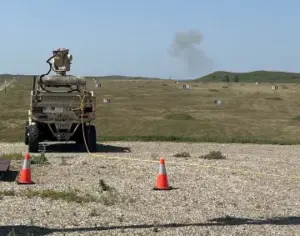
A handful of vendors participated in the first demonstration, held in July at Camp Grafton South in North Dakota, which is managed by the North Dakota National Guard. The University of North Dakota (UND), Northern Plains UAS Test Site (NPUASTS), and accessND provided the personnel and expertise to execute the demonstration.
The purpose was to collect information on the collateral effects of kinetic mitigation systems. These are systems that use the force of accelerating masses to physically alter, bring down, or destroy drones—forces such as projectiles, nets, photon plasma from lasers, and electromagnetic or radio waves. While kinetic mitigation technologies have been used by the Department of Defense before, the collateral effects of using kinetic capabilities (such as falling debris from intercepted drones) have not been clearly documented.
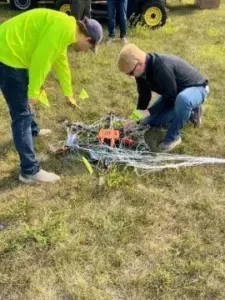
S&T partnered with UND, which is part of the FAA’s Center of Excellence for Unmanned Air Systems. “The information and data collected during this event will assist S&T in understanding, measuring, and minimizing collateral effects as kinetic C-UAS mitigation solutions are applied to Department of Homeland Security missions,” said S&T Program Manager Andy Myers.
Initial observations provided a basic understanding of collateral damage effects. Further analysis of the results will provide a basic methodology for measuring collateral effects. The primary outcomes for the Department of Homeland Security (DHS) are to develop an understanding of the kinetic mitigation capabilities of current counter-drone technologies, the inherent risks of using those capabilities, and potential damage that may result from its use.
UND, in collaboration with the NPUASTS team, delivered its report in late October, providing S&T its first analysis of the technologies demonstrated and their collateral effects. “It was an outstanding partnership that resulted in a demonstration that exceeded our expectations,” said Myers. “We now have the foundations for building a methodology for how we measure collateral effects and conducting a risk analysis for the impacts of using a given technology in a certain location, such as over a river versus a crowded city street at rush hour.”
“The opportunity for UND and the NPUASTS team to work with S&T and the FAA and demonstrate the testing and analysis capabilities within our ecosystem is priceless,” said Jordan Krueger, Research Manager at the UND Research Institute for Autonomous Systems. “We are proud to play a key role in DHS C-UAS efforts and look forward to this year’s event success and bringing additional actionable data to fruition.”
Countering swarm and ‘dark’ UAS
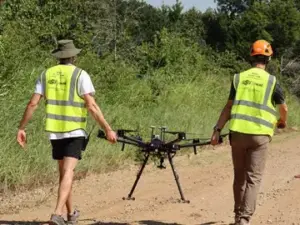
The second demonstration evaluated potential non-kinetic solutions capable of detecting, tracking, identifying, and countering swarms of small UAS that are being controlled remotely. It also assessed technologies available to detect and mitigate against drones that emit little or no radio frequency (RF) signals, noise, or emissions; these are known as “dark” drones. When used in unison for nefarious purposes, drone swarms could interfere with first responders attempting to respond to an incident at an event with national or international importance, or for a distributed assault on critical infrastructure, for example.
This demo took place in late July and early August at the Oklahoma State University (OSU) Unmanned Aircraft Flight Station in Stillwater, Oklahoma. S&T collaborated with industry partner Amentum Services, Inc. and the OSU C-UAS Center of Excellence (CoE), which is part of the Oklahoma Aerospace Institute for Research and Education (OAIRE), for the test planning and execution.
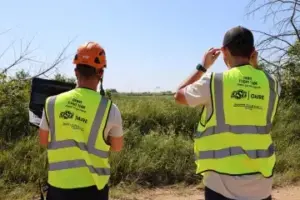
The event drew visitors from both U.S. homeland and defense agencies as well as foreign government partners. Six technology vendors also participated—three from the United States, and three were international.
“The test area was excellent in that it was representative of the open desert area across our southwest border,” said William Hatfield, counter-UAS innovation liaison for U.S. Customs and Border Protection’s (CBP) C-UAS program.
“As part of OSU’s R1 research and land-grant mission, we are dedicated to providing a service to our national and regional partners through accurate and objective data-driven evaluations,” said Shea Fehrenbach, center lead for the C-UAS CoE. “We strive to support the entire C-UAS ecosystem, which includes government, industry and academia.
“It was a pleasure working with the folks at S&T, Amentum, and the international C-UAS industry,” he continued. “Being given the opportunity to support homeland security efforts gives us a great amount of pride and we look forward to the next round of testing and evaluations.”
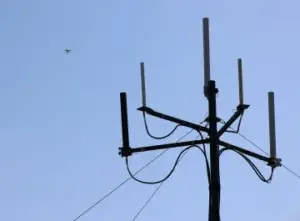
“Two of the radars recorded impressive results in their ability to detect dark drone swarms,” said Hatfield. “I was also impressed that an array of technologies was demonstrated that fills the need for a ‘system of systems’ approach that provides multiple detection capabilities to address every possible technology employed by drones.
“And, for the most part, the solutions were easy to deploy and monitor and their graphical user interfaces were very intuitive,” he added.
“The mission of the OSU Counter-UAS Center of Excellence is to work with both government and industry to provide assessments of UAS threats and evaluate the effectiveness of mitigation systems and their capability to detect, identify, and deter drone attacks both at home and abroad,” said Dr. Jamey Jacob, Executive Director of OAIRE. “This test provides a penultimate example of how universities can help both parties to provide the best value for the taxpayer.”
“The event showcased impressive capabilities in tackling a challenging problem set posed to S&T,” said Bradley Thompson, Amentum project lead. “The progress made by industry indicates promising growth and continued resolution in this critical area. It was inspiring to see what these six vendors were able to demonstrate for us in Oklahoma.”
Additional C-UAS testing is on the horizon in 2024
With such promising evaluations completed and initial findings in hand, S&T and its partners are looking forward to what’s next. “We are analyzing results from both events to determine future testing needs and where R&D investments should be made,” said S&T Program Manager Shawn McDonald.
Demonstrations for kinetic counter-drone technologies will take place this coming summer to further assess the collateral impacts of the solutions tested last summer and additional technologies that might be used by DHS components to safeguard our homeland.






